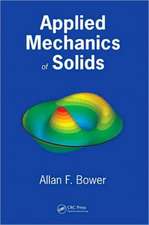Dynamics of Mechanical Systems with Coulomb Friction: Foundations of Engineering Mechanics
Autor Le Xuan Anh Traducere de Alexander Belyaeven Limba Engleză Hardback – 23 apr 2003
| Toate formatele și edițiile | Preț | Express |
|---|---|---|
| Paperback (1) | 943.73 lei 43-57 zile | |
| Springer Berlin, Heidelberg – 12 dec 2011 | 943.73 lei 43-57 zile | |
| Hardback (1) | 949.73 lei 43-57 zile | |
| Springer Berlin, Heidelberg – 23 apr 2003 | 949.73 lei 43-57 zile |
Din seria Foundations of Engineering Mechanics
- 15%
 Preț: 585.26 lei
Preț: 585.26 lei - 18%
 Preț: 1112.30 lei
Preț: 1112.30 lei - 18%
 Preț: 786.36 lei
Preț: 786.36 lei - 15%
 Preț: 650.55 lei
Preț: 650.55 lei - 15%
 Preț: 646.11 lei
Preț: 646.11 lei - 18%
 Preț: 948.47 lei
Preț: 948.47 lei - 18%
 Preț: 956.69 lei
Preț: 956.69 lei - 15%
 Preț: 643.34 lei
Preț: 643.34 lei - 18%
 Preț: 948.47 lei
Preț: 948.47 lei - 18%
 Preț: 953.82 lei
Preț: 953.82 lei - 18%
 Preț: 951.29 lei
Preț: 951.29 lei - 18%
 Preț: 1386.62 lei
Preț: 1386.62 lei - 15%
 Preț: 644.49 lei
Preț: 644.49 lei - 18%
 Preț: 2117.76 lei
Preț: 2117.76 lei - 18%
 Preț: 951.91 lei
Preț: 951.91 lei - 18%
 Preț: 957.62 lei
Preț: 957.62 lei -
 Preț: 391.99 lei
Preț: 391.99 lei - 18%
 Preț: 1223.43 lei
Preț: 1223.43 lei - 18%
 Preț: 1213.46 lei
Preț: 1213.46 lei - 15%
 Preț: 634.32 lei
Preț: 634.32 lei - 15%
 Preț: 644.30 lei
Preț: 644.30 lei - 18%
 Preț: 952.26 lei
Preț: 952.26 lei - 15%
 Preț: 646.11 lei
Preț: 646.11 lei - 15%
 Preț: 641.71 lei
Preț: 641.71 lei - 15%
 Preț: 635.01 lei
Preț: 635.01 lei - 18%
 Preț: 955.25 lei
Preț: 955.25 lei - 18%
 Preț: 1234.46 lei
Preț: 1234.46 lei - 20%
 Preț: 1289.59 lei
Preț: 1289.59 lei - 18%
 Preț: 952.89 lei
Preț: 952.89 lei - 18%
 Preț: 1247.88 lei
Preț: 1247.88 lei - 18%
 Preț: 947.18 lei
Preț: 947.18 lei - 15%
 Preț: 631.21 lei
Preț: 631.21 lei - 18%
 Preț: 1231.16 lei
Preț: 1231.16 lei
Preț: 949.73 lei
Preț vechi: 1158.20 lei
-18% Nou
Puncte Express: 1425
Preț estimativ în valută:
181.79€ • 197.53$ • 152.80£
181.79€ • 197.53$ • 152.80£
Carte tipărită la comandă
Livrare economică 21 aprilie-05 mai
Preluare comenzi: 021 569.72.76
Specificații
ISBN-13: 9783540006541
ISBN-10: 3540006540
Pagini: 280
Ilustrații: IV, 272 p.
Dimensiuni: 160 x 240 x 22 mm
Greutate: 0.57 kg
Ediția:2003
Editura: Springer Berlin, Heidelberg
Colecția Springer
Seria Foundations of Engineering Mechanics
Locul publicării:Berlin, Heidelberg, Germany
ISBN-10: 3540006540
Pagini: 280
Ilustrații: IV, 272 p.
Dimensiuni: 160 x 240 x 22 mm
Greutate: 0.57 kg
Ediția:2003
Editura: Springer Berlin, Heidelberg
Colecția Springer
Seria Foundations of Engineering Mechanics
Locul publicării:Berlin, Heidelberg, Germany
Public țintă
ResearchCuprins
1 Development of the theory of motion for systems with Coulomb friction.- 1.1 Coulomb’s law of friction.- 1.2 Main peculiarities of systems with Coulomb friction and the specific problems of the theory of motion.- 1.3 Various interpretations of Painlevé’s paradoxes.- 1.4 Principles of the general theory of systems with Coulomb friction.- 1.5 Laws of Coulomb friction and the theory of frictional selfexcited oscillations.- 2 Systems with a single degree of freedom and a single frictional pair.- 2.1 Lagrange’s equations with a removed contact constraint.- 2.2 Kinematic expression for slip with rolling.- 2.3 Equation for the constraint force and Painlevé’s paradoxes.- 2.4 Immovable contact and transition to slipping.- 2.5 Self-braking and the angle of stagnation.- 3 Accounting for dry friction in mechanisms. Examples of single-degree-of-freedom systems with a single frictional pair.- 3.1 Two simple examples.- 3.2 The Painlevé-Klein extended scheme.- 3.3 Stacker.- 3.4 Epicyclic mechanism with cylindric teeth of the involute gearing.- 3.5 Gear transmission with immovable rotation axes.- 3.6 Crank mechanism.- 3.7 Link mechanism of a planing machine.- 4 Systems with many degrees of freedom and a single frictional pair. Solving Painlevé’s paradoxes.- 4.1 Lagrange’s equations with a removed constraint.- 4.2 Equation for the constraint force, differential equation of motion and the criterion of paradoxes.- 4.3 Determination of the true motion.- 4.4 True motions in the Painlevé-Klein problem in paradoxical situations.- 4.5 Elliptic pendulum.- 4.6 The Zhukovsky-Froude pendulum.- 4.7 A condition of instability for the stationary regime of metal cutting.- 5 Systems with several frictional pairs. Painlevé’s law of friction. Equations for the perturbed motion takingaccount of contact compliance.- 5.1 Equations for systems with Coulomb friction.- 5.2 Mathematical description of the Painlevé law of friction.- 5.3 Forces of friction in the Painlevé-Klein problem.- 5.4 The contact compliance and equations of perturbed trajectories.- 5.5 Painlevé’s scheme with two frictional pairs.- 5.6 Sliders of metal-cutting machine tools.- 5.7 Concluding remarks about Painlevé’s paradoxes.- 6 Experimental investigations into the force of friction under self-excited oscillations.- 6.1 Experimental setups.- 6.2 Determining the forces by means of an oscillogram.- 6.3 Change in the force of friction under break-down of the maximum friction in the case of a change in the velocity of motion.- 6.4 Dependence of the friction force on the rate of tangential loading.- 6.5 Plausibility of the dependence F+(f).- 6.6 Characteristic of the force of sliding friction.- 7 Force and small displacement in the contact.- 7.1 Components of the small displacement.- 7.2 Remarks on friction between steel and polyamide.- 7.3 Conclusions.- 8 Frictional self-excited oscillations.- 8.1 Self-excited oscillations due to hard excitation.- 8.2 Self-excited oscillations under both hard and soft excitations.- 8.3 Accuracy of the displacement.- References.
Textul de pe ultima copertă
This book addresses the general theory of motion of mechanical systems with Coulomb friction. In particular, the book focuses on the following specific problems: i) derivation of the equations of motion, ii) Painleve's paradoxes, iii) tangential impact and dynamic seizure, and iiii) frictional self-excited oscillations.
In addition to theoretical results, the book contains a detailed description of experiments that have been performed. These show that, in general, the friction force at the instant of transition to motion is determined by the rate of tangential load and does not depend on the duration of the previous contact. These results are used to develop the theory of frictional self-excited oscillations. A number of industrially relevant mechanisms are considered, including the Painleve-Klein scheme, epicyclic mechanisms, crank mechanisms, gear transmission, the link mechanism of a planing machine, and the slider of metal-cutting machine tools.
The book is intended for researchers, engineers and students in mechanical engineering.
In addition to theoretical results, the book contains a detailed description of experiments that have been performed. These show that, in general, the friction force at the instant of transition to motion is determined by the rate of tangential load and does not depend on the duration of the previous contact. These results are used to develop the theory of frictional self-excited oscillations. A number of industrially relevant mechanisms are considered, including the Painleve-Klein scheme, epicyclic mechanisms, crank mechanisms, gear transmission, the link mechanism of a planing machine, and the slider of metal-cutting machine tools.
The book is intended for researchers, engineers and students in mechanical engineering.
Caracteristici
Addresses the general theory of mechanical systems with Coulomb friction Comparison between theory and experiments Stands in the Russian tradition of connecting highly sophisticated theory with engineering applications Includes supplementary material: sn.pub/extras








